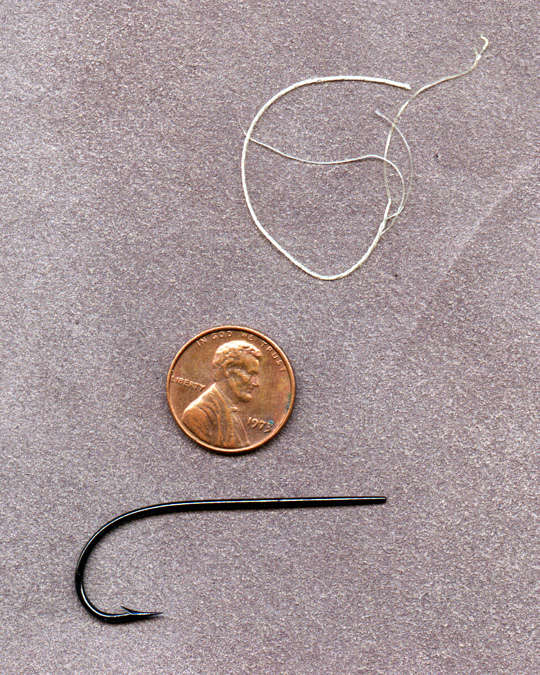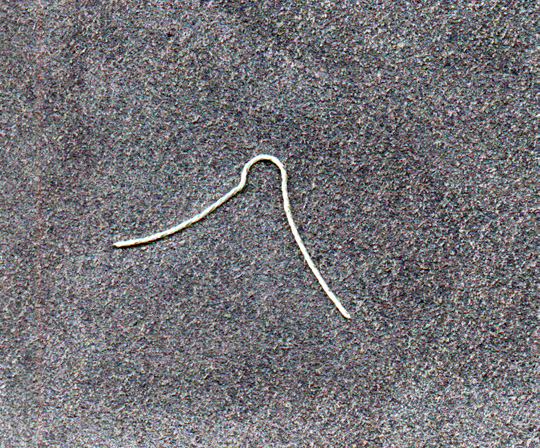Silk Gut on a Fishing Fly
I’ve found someone (actually, he found me!) who makes authentic old-style tied fishing flies. I’ve read references to the use of silk gut – WARNING: silkworm gut is exactly what it sounds like! in them, but no clear detailed information on how it’s actually put together. These are some photos of a fly-in-progress by Paul Martin.

This shows the strands of gut, partly twisted together, and the hook. According to Paul, this is “a 3/0 Seeley sproat antique hook” – I don’t know anything about antique fishhooks, so please don’t ask me what that means. Note that the non-hook end of the hook (the shank, maybe?) doesn’t have an eye – that’s where the silk gut comes in!

This is the gut twisted and shaped to go onto the hook.

Here, Paul has secured the gut eye to the hook with thread wrapping, and some “head cement.”

This is one of Paul’s finished flies; it’s his rendition of a Blacker fly from the 1800’s. It is not the same hook as the one he’s been attaching the gut to in the photos above, but the process is the same. Notice that there is flat (untwisted) dyed silk wrapped onto the body of the fly – that’s what makes the yellow colored area toward the hook end. I’m going to make Paul some hand-pulled gut strands, and also dye some flat silk for him from reeled filament.

Wow! And I’ve even heard of Mr Martin…
Dang cool!
I hadn’t heard of him before he emailed, but he seems like a Really Cool Guy! I’m looking forward to the trade. Learning how the silk gut is used has been worth it in itself; I’ve been fiddling around with the (very cool) stuff for a while, but hadn’t found specific info on the fishing uses.
Okay, now I really am grudging the cooler weather and wanting it to be summer so I can go cast a few on the surface and make them glide enticingly.
and BOY would those make sexxxi ear rings if nt for the painful looking hook part! 🙂
Yeah… particularly with those antique forged hooks, I bet it would be dangerous!
He’s going to design some special for me with peacock feathers. I figure shadow-box them and hang on the wall, although I wish there were something related that would be tied-fly-like without the wicked sharp part!
Are you thinking of making some? I might be able to hook you up with some cool feathers.
I’m going to send silk and gut to Paul, and he’s going to make some flies for me. It intrigues me, in a “oh, cool!” sort of way, but it’s not anything I’m particularly interested in doing myself.
I love cool feathers, though – I use them in a variety of crafts, from hats to jewelry. What kinds do you have?
So many I can’t list them. I worked in the bird dept at the San Diego Wild Animal Park, so I have a very nice collection. I aslo have some very cool eggs. 🙂
How neat!
I’ll have to come begging if I come up with a project that needs something really special.
I imagine the fishing-fly guys have long and specific lists; I read one of their forums for a little bit, and they’re using all kinds of exotic feathers like toucan, and Indian crow, and specialty pheasants.
So… the idea is to lay the fly on top of the water like a lighting bug, and not have it sink, right?
I know *nothing* about fly fishing (clearly!) and haven’t found a good very-very-basic tutorial. All the stuff I can find is more about finer points…
You are right in the first sentence. It’s a way of excersise that puts you in a beautiful setting, listening to everything around you, and balancing this wee bit of artistry on the miniscus of your body of water and swerve it around the surface to look like a swimming bug.
Watch out for the bears.
LOL